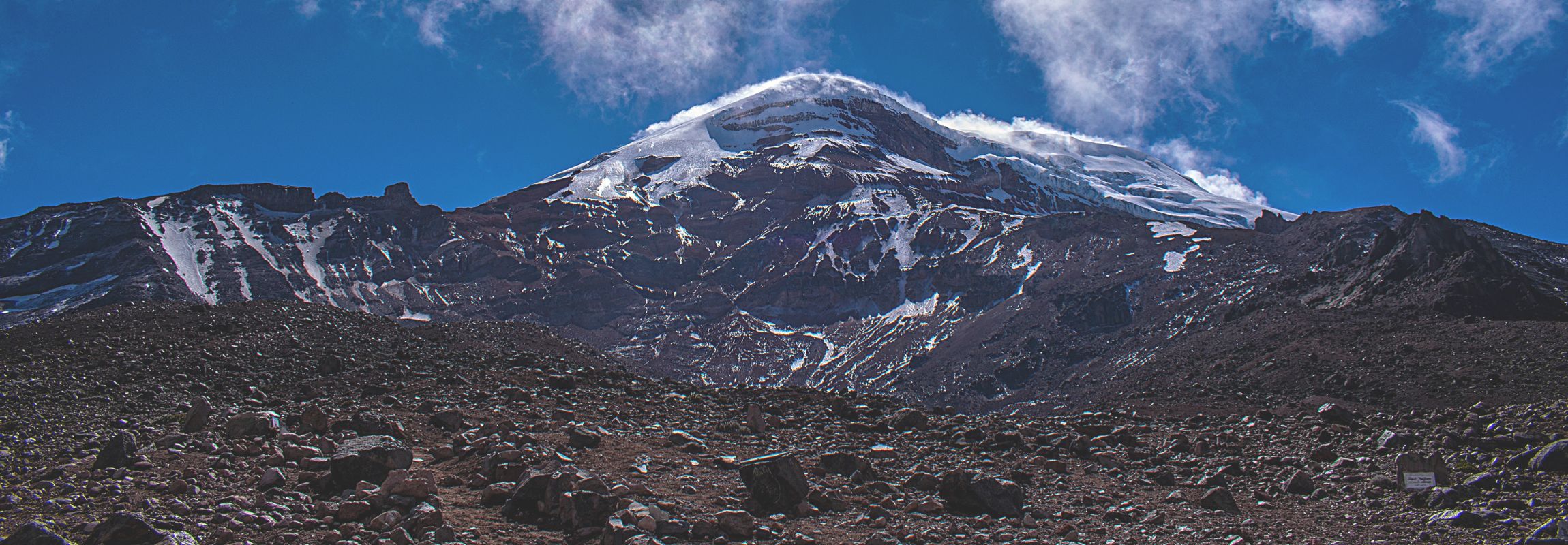
Ecuador Welcome Package
When you choose to travel to Ecuador, you select one of the most biodiverse and culturally dynamic countries in South America and the world. Making the most of your time in this beautiful country becomes even easier when armed with all the essential information. Knowing what to pack, what weather to expect, how transportation works, and which electric outlets are used, can go a long way. At Rebecca Adventure Travel, we aim to put all your doubts at ease and ensure your trip to Ecuador is seamless and unforgettable. Read through our Ecuador Welcome Package, and feel free to contact us if you still have any questions about this fascinating country.
Welcome to the breathtaking and diverse landscapes of Ecuador, presented to you by Rebecca Adventure Travel. As you embark on this unforgettable journey, we open the doors to an awe-inspiring experience in this South American gem. Let us help you prepare for your trip and seize every opportunity to the fullest.
Ecuador Geography: The Most Biodiverse Country on Earth
Ecuador, a hidden gem nestled in the northwestern part of the South American continent, unveils a land of astonishing diversity that rivals even the grandest of landscapes. Despite its smaller size compared to neighboring giants, this captivating nation holds the title of being one of the most biodiverse countries on Earth. Its unique geographical tapestry reveals four distinct and awe-inspiring regions, each offering a kaleidoscope of natural wonders and cultural riches.
- The Amazon Rainforest (La Amazonía): In the eastern part of Ecuador, the Amazon rainforest thrives with an abundance of flora and fauna. The dense jungle is home to a wide range of plant and animal species, and the region is deeply connected to indigenous communities with their traditional ways of life.
- The Andes Mountains (La Sierra): Stretching through the heart of Ecuador, the Andes Mountains showcase jagged peaks, lush valleys, and highland plateaus. Indigenous communities still preserve their ancient traditions, and the region is dotted with charming mountain villages and historical sites.
- The Coastal Region (La Costa): This western region boasts stunning golden beaches along the Pacific Ocean. Rich mangrove forests line the coast, providing habitats for diverse marine and bird life. Coastal cities and towns offer a mix of traditional Ecuadorian culture and modern amenities.
The Galapagos Islands: Situated off the coast, the Galapagos Islands are a living laboratory of evolution. Isolated from the mainland, unique wildlife species have thrived, attracting nature enthusiasts and researchers from around the world.
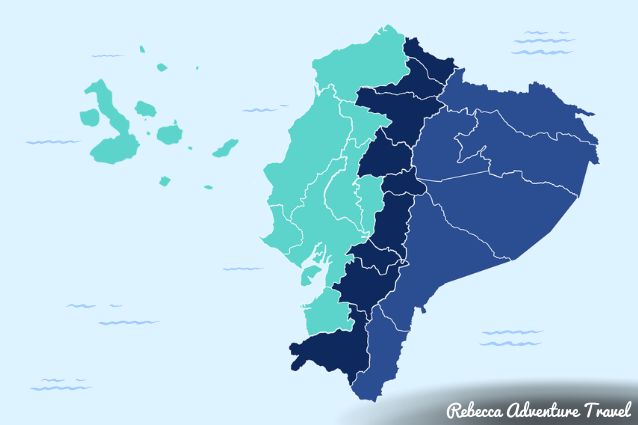
Ecuador map.
Ecuador Weather by Region: Best Time to Travel to Ecuador
Countries situated near the Equator experience minimal seasonal variation compared to those more affected by the Earth’s tilted axis. Ecuador, being located right on the planet’s circumference, benefits from this advantageous position. Throughout the year, Ecuador enjoys relatively consistent daylight and darkness, leading to two distinct seasons – the rainy and the dry. However, these seasons and their temperatures vary depending on the region and altitude due to Ecuador’s dramatic geography. Thanks to this diversity, each season unveils its own unique charm, making Ecuador an ideal year-round travel destination. Now, let us be your guide as we explore the weather characteristics of each region, providing you with a deeper understanding of this captivating country’s climate.
What’s the Weather like in the Amazon
The Amazon region beckons with its lush and vibrant rainforest, where rainfall graces the landscape throughout the year. However, there are two relatively drier periods to note: January-February and August-September. The western part of the Amazon tends to be wetter than the eastern counterpart. As you venture into this biodiverse realm, expect temperatures ranging from 23°C to 27°C.
What’s the Weather like in the Andes
Stretching across altitudes ranging from 1,500 meters to a towering 6,310 meters, the Ecuadorian Andes offer a breathtaking backdrop for unforgettable adventures. Most cities in this mountainous region nestle between 2,000 and 3,000 meters above sea level, where temperatures typically vary from 15°C to 20°C. The Andes experience a drier season during June, July, August, and September, providing ideal conditions for exploration.
What’s the Weather like on the Coast
As you traverse Ecuador’s Coast, you’ll encounter varying levels of rainfall from north to south. The northwest coast boasts a wet tropical seasonal climate, while the climate becomes increasingly drier as you move further south. The rainy season embraces the coast from December to May, followed by an almost dry season from June to November. Along the coast, temperatures range from 25°C to 31°C, making it a perfect destination for beach lovers.
What’s the Weather like in the Galapagos Islands
The Galapagos Islands offer a mesmerizing subtropical climate, divided into two distinct seasons. From December to May, the islands experience a warm season, marked by a delightful blend of warmth, rain, and sunshine. The cooler season takes place from June to November, characterized by cloudiness, cooler temperatures, and dry weather. Ocean currents significantly influence these seasonal variations, leading to choppy seas during the cooler months. For snorkeling enthusiasts, wetsuits are recommended to ensure a comfortable and enjoyable experience. Temperatures in the Galapagos range from 21°C in August and September to 28°C in March and April.
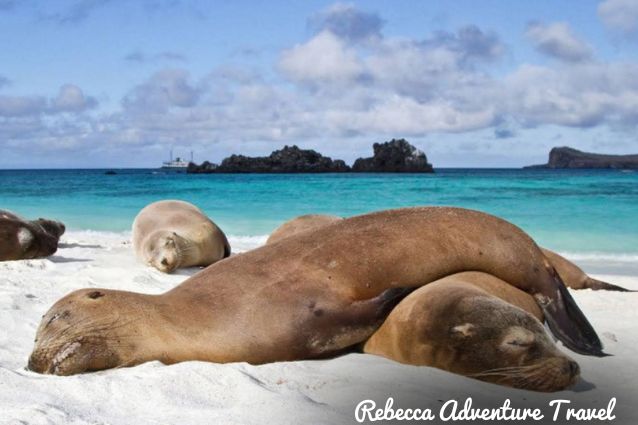
Family of Sea Lions sleeping.
General Information: Embracing Ecuadorian Culture
As you immerse yourself in Ecuador’s wonders, understanding its culture is essential. Here are some tips to enhance your experience:
Greeting People: A Friendly Encounter
Greetings hold great importance in Ecuador, so let us help you get it right. Saying “hi” when entering shops, restaurants, taxis, and other establishments is customary. Remember, “Buenos Dias” is used in the morning, “Buenas Tardes” in the afternoon, and “Buenas Noches” in the evening. Men usually shake hands for greetings, while women exchange kisses on one cheek. For mixed-gender greetings, a kiss on the cheek is also appropriate.
Religion: A Tapestry of Faith
Ecuador is primarily a Catholic nation, but in recent years, other religions have seen an increase in followers. Colonial towns showcase magnificent churches, testaments to the country’s rich religious history.
Meals: Savoring Ecuadorian Cuisine
Ecuadorian cuisine tantalizes the taste buds with its rich and varied flavors, leaving you satisfied to the last bite. Each region offers a delightful array of dishes, highlighting the freshest produce and region-specific proteins. From vegetables and aromatic spices to rice, potatoes, meat, pork, chicken, seafood, and an abundance of fruits, the ingredients create a mouthwatering symphony of flavors in every meal. Lunch, celebrated as the most important meal of the day, takes center stage with “almuerzo” menus in local restaurants offering hearty soups, flavorful main courses, and refreshing fruit-based drinks. While savoring the culinary delights, keep in mind that tap water may not be safe for foreigners, so it’s best to opt for closed bottled water. Additionally, exercise caution when sampling street food to fully enjoy the delectable Ecuadorian cuisine.
Ecuador Travel Tips: When exploring Ecuador’s culinary delights, indulge in the mouthwatering flavors of each region. In the Andes, savor pork and potato-based dishes like fritada, hornado, llapingachos, and locro. Vegetarian options abound with delectable recipes featuring corn, broad beans, lupin beans, quinoa, and heart of palm. As you venture to the coastal region, relish traditional dishes crafted with seafood, green plantains, and peanut sauce. Don’t miss out on ceviche, conchas asadas, bolón de verde, and tigrillo. These regional delights are beloved and available throughout the country, promising a delightful gastronomic journey across Ecuador.
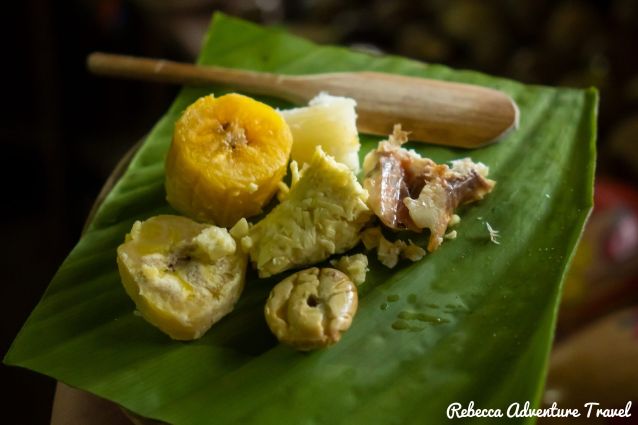
Traditional Ecuadorian Amazon food.
Money: Navigating Currency in Ecuador
The official currency in Ecuador is the US dollar, with bills identical to those used in the United States. Ensure you use Ecuadorian coins before leaving, as they won’t be accepted elsewhere. While most establishments accept bills up to $20, it’s wise to carry smaller currency denominations. ATMs are available, with a daily withdrawal limit usually around $300 per card. Inform your bank of your travel plans and check for any foreign transaction fees.
Tipping Etiquette: Expressing Gratitude
Gratuities are a customary gesture of appreciation in Ecuador. In shared tours, an average tip of $5 per person is fitting for excellent service, while private tour guides usually receive an average tip of $10 per day. Drivers generally receive half the amount if they provide exceptional service. For multi-day tours like cruises and jungle programs, tipping around $50-$60 per client per week is recommended, distributed among the crew. Many restaurants include a 10% service charge, but if the service surpasses expectations, an additional $2-$5 tip is appreciated. Hotel porters usually receive around $0.50 per bag.
Public Transportation: Getting Around
Public transportation in Ecuador is affordable, with buses or trolleys in Quito costing just 25 cents, and taxis ranging from $2 to $5, depending on the destination. Only take taxis with fare meters, as unregistered taxis may overcharge. Prices may increase at night, and some taxis might refuse to use meters after dark. Using Uber or Cabify is recommended for taxi services.
Safety: A Smart and Mindful Journey
When visiting Quito, Guayaquil or other major towns and cities, it’s advisable to be cautious. Like in most places in South America, it’s smart to avoid carrying large wallets or keeping valuables in your pockets. Don’t walk with your phone in your hand if you can help it as it may draw unnecessary attention. Secure important documents and valuables in your hotel’s safety deposit box and carry photocopies of your passport. After 6:00 PM, opt for taxis from hotels or restaurants for safe evening outings. Keep your personal belongings close to you and consider using small, inconspicuous bags.
Visas: Planning Your Stay
Unless you are from China, you typically don’t need a visa for stays up to 90 days. For longer stays, you must obtain a 6-month Tourist visa (12-IX) from your local Ecuadorian Embassy.
Arrival: A Warm Welcome
Most of our multiple-day tours offer airport pick-up services. In case yours doesn’t, it can be added to your package. After immigration and baggage claim, a driver with a sign bearing your name will greet you. You will be promptly transported to your accommodation. If any delays occur, kindly contact us. Arranging transportation beforehand can be a time saver when traveling.
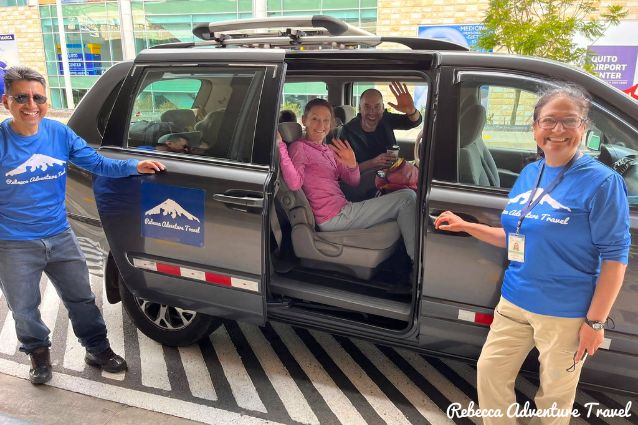
A warm welcome at the airport.
Internet: Staying Connected
Internet access is widely available in Quito, Guayaquil and bigger towns, with most restaurants and tourist spots offering Wi-Fi for free. Many hotels provide free Wi-Fi as well. Internet cafes are also present, with competitive prices, averaging around $0.50 per hour. Even in remote villages, you can expect internet availability for a reasonable fee, generally not exceeding $3 per hour. When leaving a city or town, internet signal may be intermittent.
Telephone: Communication Made Easy
For cost-effective calls, you can visit local internet cafes but they are not as commonplace as they used to be. We suggest you purchase an Ecuadorian SIM card for approximately $5, but ensure your phone is unlocked to use it. Contact your telephone provider before your trip to check compatibility. The international dialing code for Ecuador is +593.
Electricity: Powering Up
Ecuador uses 110 volts and 60 cycles, resulting in low wattage for most light bulbs. Some electric devices, like hairdryers, may not work without an adapter. The country generally accepts two types of plugs – American-style plugs with two parallel flat blades above a circular grounding pin or Japanese-style plugs with just two parallel flat blades.

American-style plugs.
What to Wear in Ecuador
When embarking on an Ecuadorian adventure, knowing what to wear is essential for a comfortable and enjoyable journey. With its diverse regions and varying temperatures, being well-prepared ensures that you make the most of your travels. From the lush Amazon rainforest to the majestic Andes mountains, the sandy Pacific Coast, and the enchanting Galapagos Islands, each region demands specific attire to match its climate. Properly outfitting yourself according to the local conditions is one of the key Ecuador travel tips to ensure a seamless and memorable experience.
Amazon: Warm and humid
Embrace the wonders of the rainforest by bringing light clothing, long-sleeve shirts, raincoats, comfortable pants, and plastic bags to protect your camera and documents. Lodges often provide rubber boots, but do check if your shoe size exceeds 43. Wear breathable materials to stay fresh.
Andes: Dry, warm, and cold
In the Andes, where temperatures fluctuate throughout the day, layering your clothing is key. Don’t forget to pack warm, light, and comfortable clothing, as well as sunblock and sunglasses. At night, temperatures tend to drop so carry a warm sweater and jacket with you.
Coast: Warm and humid, or cool and humid
In the coastal region, temperatures are warm for the most part. At night it will usually feel cooler so packing a light jacket is always a good idea. Take your bathing suit with you as you will surely take a plunge in the fresh waters of the Pacific Ocean. Remember to wear sunscreen and reapply constantly, as the equatorial sun can tan the skin faster than you think.
Galapagos Islands: Warm and humid, or cool and dry
For Galapagos cruises, tours, and island-hopping adventures, travel light with small luggage and bags. Seasickness pills are a good idea if you are planning on taking a cruise ship. Pack light and comfortable clothing, sunblock, and sunglasses. Don’t forget to pack walking shoes because the Galapagos volcanic terrain is rugged and uneven.
Packing List for Ecuador
To ensure a smooth and comfortable journey, we recommend you pack the following items from our packing list. Choose appropriately according to the regions of Ecuador you will be visiting and the time of year.
Ecuador Travel Tips: As a general rule, don’t try to adhere too strictly to the two seasons in the country. Temperatures and weather conditions around the world are constantly changing, and Ecuador is no exception. The key is to embrace versatility and opt for layers in your clothing choices. This way, you can easily adjust to the fluctuating weather and ensure comfort throughout your journey.
Personal Documents
- Passport, insurance certificates, and personal documentation
- Photocopies of all the above
- Sufficient spending money in cash
Essential Travel Gear
- Camera, charger, and adapter
- Sunglasses and sunscreen
- Water bottle
- Day pack/rucksack for everyday use
- Items for personal enjoyment, such as books, cards, and music
- Guidebook on Ecuador (e.g. Lonely Planet, Footprints, Rebecca Adventure Travel’s Welcome Package)
- Personal hygiene items, including deodorant, soap, shampoo, and toothbrush
- Spanish dictionary
- Medical kit containing altitude/sea sickness, anti-diarrhea tablets, antihistamines, and painkillers and any specific medication you might be taking
- Mosquito repellent
Clothing Items
- Hat and sandals
- Comfortable walking shoes
- A pair of thick socks for walking
- Waterproof jacket
- Long trousers
- Swimwear & towel
- Long-sleeve shirts and tank tops
- Warm sweater
We hope this comprehensive guide equips you with all you need for an unforgettable exploration of Ecuador’s natural wonders. Prepare yourself to immerse in the breathtaking beauty and vibrant culture of this captivating country. Happy travels!
Contact Numbers
If you have any questions, please do not hesitate to contact us:
- 24/7 General & Sales Enquiries Phone: +593-(0)980051675
- Office in Quito: +593-(0)2-6007590
We hope this Ecuador Welcome Package page was helpful to you. On behalf of the whole Rebecca Adventure Travel Team, we wish you the happiest, most joyful, and most beautiful time in Ecuador!








